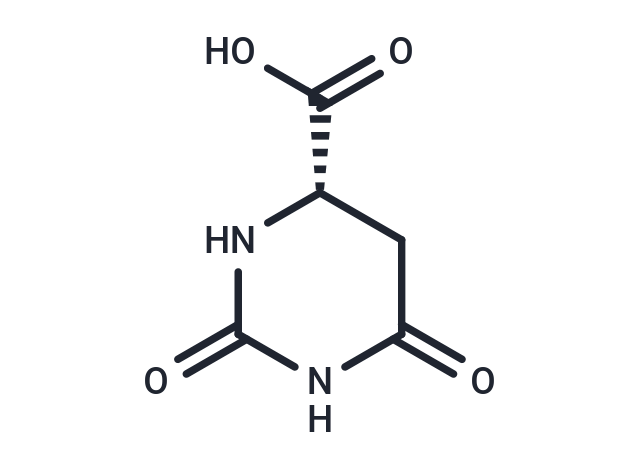- Remove All
 Your shopping cart is currently empty
Your shopping cart is currently empty
L-Dihydroorotic acid
L-Dihydroorotic acid, also known as (S)-4,5-dihydroorotate or dihydro-L-orotate, belongs to the class of organic compounds known as alpha amino acids and derivatives. Within the cell, L-dihydroorotic acid is primarily located in the cytoplasm and mitochondria. L-Dihydroorotic acid exists in all eukaryotes, ranging from yeast to humans. L-Dihydroorotic acid participates in a number of enzymatic reactions. In particular, L-Dihydroorotic acid can be biosynthesized from ureidosuccinic acid; which is catalyzed by the enzyme cad protein. In addition, L-Dihydroorotic acid and quinone can be converted into orotic acid; which is mediated by the enzyme dihydroorotate dehydrogenase (quinone), mitochondrial. In humans, L-dihydroorotic acid is involved in the pyrimidine metabolism pathway. L-Dihydroorotic acid is also involved in several metabolic disorders, some of which include UMP synthase deficiency (orotic aciduria), the mngie (mitochondrial neurogastrointestinal encephalopathy) pathway, Beta ureidopropionase deficiency, and dihydropyrimidinase deficiency.

L-Dihydroorotic acid
| Pack Size | Price | Availability | Quantity |
|---|---|---|---|
| 50 mg | $30 | In Stock | |
| 100 mg | $39 | In Stock | |
| 500 mg | $138 | In Stock | |
| 1 g | $198 | In Stock | |
| 1 mL x 10 mM (in DMSO) | $39 | In Stock |
Product Introduction
| Description | L-Dihydroorotic acid, also known as (S)-4,5-dihydroorotate or dihydro-L-orotate, belongs to the class of organic compounds known as alpha amino acids and derivatives. Within the cell, L-dihydroorotic acid is primarily located in the cytoplasm and mitochon |
| Alias | L-Hydroorotic acid |
| Molecular Weight | 158.11 |
| Formula | C5H6N2O4 |
| Cas No. | 5988-19-2 |
| Smiles | OC(=O)[C@@H]1CC(=O)NC(=O)N1 |
| Relative Density. | 1.523 |
| Storage | Powder: -20°C for 3 years | In solvent: -80°C for 1 year | Shipping with blue ice. | |||||||||||||||||||||||||||||||||||
| Solubility Information | DMSO: 50 mg/mL (316.24 mM), Sonication is recommended. | |||||||||||||||||||||||||||||||||||
Solution Preparation Table | ||||||||||||||||||||||||||||||||||||
DMSO
| ||||||||||||||||||||||||||||||||||||
Calculator
In Vivo Formulation Calculator (Clear solution)
Dose Conversion
Tech Support
Keywords

Copyright © 2015-2025 TargetMol Chemicals Inc. All Rights Reserved.



